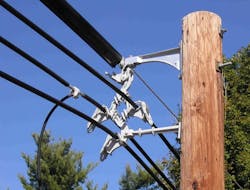Electric utilities in the U.S. and around the world have been increasingly grappling with wildfires over the last couple of decades. Of particular concern are wildfires caused by power lines. These are especially troublesome considering public safety concerns and property losses. As such, a fundamental goal in designing power lines for operation in wildfire-prone regions is to ensure the lines are hardened against the potential to ignite a fire. The emphasis here is not about wildfire survival but rather preventing wildfire ignition in the first place.
While numerous techniques exist to harden a system to survive wildfires — such as brush clearing, prediction, monitoring, smart grid, pole changeouts and public safety power shutoffs — the ultimate goal is to prevent ignition by system design.
Bare Wire Lines
Wildfire ignition incidents connected with power lines have been tied exclusively to bare wire lines, which are fundamentally susceptible to being a source of ignition. Bare wire lines can contact trees or fall to the ground and start a fire. Even if a line falls to the ground deenergized, it can encounter a stone or hard object and throw a spark, causing ignition. Some protective-relaying schemes have been devised to anticipate a line falling to the ground and deenergizing the line before it hits the ground. While this is a valuable tool, if bare metal hits a rock and throws a spark, ignition can still occur.
Some utilities have chosen to use interphase spacers on bare wire lines, posing the risk of conductor clashing — in which high winds cause one conductor to blow into another, producing high-temperature plasma particles that inevitably fall to the ground and serve as a potent source of ignition. The interphase spacers are installed between the phase conductors, midspan, and prevent the conductors from touching during high-wind events.
A more recently introduced strategy is the use of flame-retardant (FR) insulators. Wildfires can reach temperatures of 1100°F to 2000°F (593°C to 1093°C), yet the high-density polyethylene (HDPE) material used in distribution insulators can ignite at a much lower temperature—around 650°F (343°C)—so a passing, or static, wildfire can still ignite the insulator at the top of the pole. In contrast, if FR insulators are ignited, they self-extinguish when the flame is removed and prevent flaming drips of polyethylene from dropping down onto ignitable material that may be lying on the crossarm or ground below.
Undergrounding Power Lines
Undergrounding has become a standard go-to strategy for wildfire mitigation. Popular among residents and regulators alike, underground lines are aesthetic, cannot throw a spark onto dry brush and are not bothered by vegetation contact.
The first and perhaps insurmountable obstacle is underground lines often cost five times to 10 times the cost of bare wire construction — and are even more costly to install in locations with legacy infrastructure. So, while undergrounding is a technically viable and extremely attractive option for wildfire mitigation, it also comes with a cost structure that may be difficult to justify systemwide.
Aerial-Covered Conductor
Another option utilities have is to use aerial-covered conductor to minimize the potential for wildfire ignition. There are two types of construction: spacer cable and tree wire.
Spacer cable systems consist of three heavily covered yet unshielded phase conductors. The conductors are usually all-aluminum conductor (AAC) when in a spacer configuration, because there is no tension on the phase conductors, but aluminum conductor steel-reinforced (ACSR) or all-aluminum alloy conductor (AAAC) when installed in a self-supported, or tree wire, configuration.
In spacer cable construction, the phase conductors are attached to a messenger by spacers, installed every 30 ft (10 m) along the messenger. The messenger is a high-strength alumoweld (AW) or alumoweld-aluminum (AWA) conductor, which has several functions. The messenger is the mechanical strength member, holding the phase conductors up. The messenger can also be used as a system neutral, serve as a lightning shield and provide a mechanical protection function by protecting the phase conductors from any items (such as leaves branches and trees) that can fall onto the bundle from above. The spacers are made of HDPE, as are the pin or line-post insulators used on the angles, to ensure dielectric compatibility with the phase conductors.
On the other hand, tree wire systems look more like bare wire construction. They use the same three-layer covered conductor design, but the phase conductors are usually either ACSR or AAAC (since they are fully self-supported and tensioned).
Tree wire systems are strung in an open wire configuration on crossarms with polyethylene insulators.
While there are numerous differences in operational effectiveness between spacer cable and tree wire systems, with regard to their efficacy as wildfire mitigation tools, the following three attributes of covered conductor systems directly help to mitigate the risk of power line-related ignitions in wildfire-prone areas:
- If a covered conductor line blows into trees or branches, there is not enough contact current to cause ignition.
- If a covered conductor line is impacted physically and falls to the ground, there is not enough current to ignite dry brush or other fuel that may be present.
- If a covered conductor line falls to the ground and hits
a rock, the polyethylene covering does not cause a spark to be thrown (unlike a bare wire, where a spark and subsequent ignition of dry brush would be possible.)
The Differences
A few differences exist between spacer cable and tree wire systems with respect to wildfire mitigation effectiveness. If a tree wire configuration is used, an overhead tree could fall onto the line, abrade the conductor covering over time and result in a failure. This can reduce the attractiveness of tree wire in wildfire-prone areas that have an abundance of trees, in favor of spacer cable.
Additional differences arise in relation to the presence, removal and trimming of foliage, since spacer cable uses less right-of-way (ROW) than tree wire.
For the spacer cable configuration, even with fully compliant clearances, much more of the tree remains intact. The reduced ROW (and, hence, additional remaining foliage) does not increase the risk of ignition when using the spacer cable configuration. If branches become weighted down with wind or rain and touch the power bundle, they will be supported by the high-strength messenger, which is suitably grounded at every pole, or every other pole. This is one fundamental and vital function of the overhead messenger: to protect the phase conductors beneath it from objects that may fall on the power line from above.
Not all power line-related wildfires initiate with branches falling from above. A significant part of the wildfire-prone landscape consists of dense scrub, tangled bushes and what is more commonly known as chaparral. These plants do not threaten power lines from up above but are a potent source of fuel for wildfires from below.
Further, there are cases of palm fronds being ignited by fire and traveling hundreds of yards with the wind. A palm frond flying between two phases of a bare wire system can be a concern. Note that fire is plasma and conducts electricity, since it is essentially an ionized gas consisting of ions and free electrons. If the ignited palm frond gets between the two bare wire phases, a flashover is likely. This could create a new wildfire location beneath the power line. The use of a covered conductor can prevent this scenario. As such, when there are no trees, it is viable to use covered conductor in a tree wire configuration.
Conversely, when trees are present, spacer cable is recommended because it will prevent ignition and protect the phase conductors from objects that threaten the power line from above and below.
Operational Strategy
Utilities can design power lines with covered conductor to minimize the potential for wildfire ignition. However, can this have ramifications for electric utility operational strategies during wildfire season? Common to wildfire-prone areas are public safety power shutoffs, whereby a utility can turn off the power if conditions (high winds, dry climes, high fuel load on the ground) indicate a wildfire is a possibility. At least one utility has stated that, in addition to its wildfire mitigation benefits, covered conductor has some public safety power shutoff benefits as well, raising the threshold for when to enact this to higher wind speeds than those used for bare wire systems.
The threat of wildfires being ignited by power lines is a reality for electric utilities. While bare wire, underground and covered conductor line designs all have mitigating strategies available in the design stage, those strategies also have their own costs and effectiveness (or lack thereof). Covered conductor systems, both spacer cable and tree wire, are proven and cost-effective design tools for wildfire mitigation.
Brian J. Trager ([email protected]) is a Senior Life Member of the IEEE. He received his BSEE and MSEE degrees from Rensselaer Polytechnic Institute in New York in 1978 and 1980, respectively, and a MBA degree in finance from the University of Pittsburgh in 1986. Trager has held various positions in engineering, consulting and management at American Electric Power Co., Cooper Power Systems and Fisher-Pierce, and most recently at Hendrix Wire and Cable, where he is currently employed as director, technology and international. He has taught electric power engineering at Ohio State University, West Virginia University and Pennsylvania State University, in addition to teaching courses to utility clients, and has authored over 75 technical papers and articles for the IEEE and other national and international organizations.
About the Author
Brian J. Trager
Brian J. Trager ([email protected]) is a Senior Life Member of the IEEE. He received his BSEE and MSEE degrees from Rensselaer Polytechnic Institute in New York in 1978 and 1980, respectively, and a MBA degree in finance from the University of Pittsburgh in 1986. Trager has held various positions in engineering, consulting and management at American Electric Power Co., Cooper Power Systems and Fisher-Pierce, and most recently at Hendrix Wire and Cable, where he is currently employed as director, technology and international. He has taught electric power engineering at Ohio State University, West Virginia University and Pennsylvania State University, in addition to teaching courses to utility clients, and has authored over 75 technical papers and articles for the IEEE and other national and international organizations.




